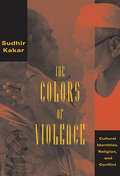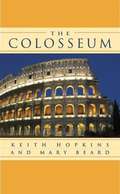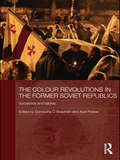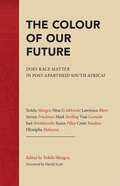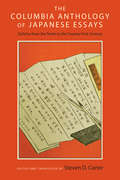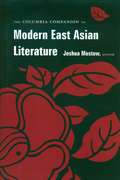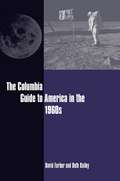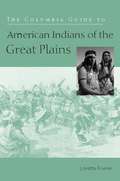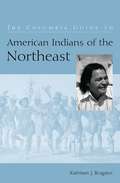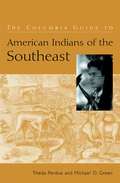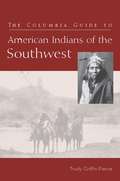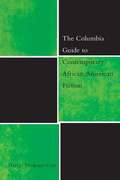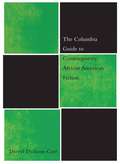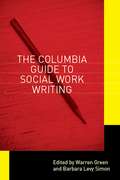- Table View
- List View
The Colors of Violence: Cultural Identities, Religion, and Conflict
by Sudhir KakarFor decades India has been intermittently tormented by brutal outbursts of religious violence, thrusting thousands of ordinary Hindus and Muslims into bloody conflict. In this provocative work, psychoanalyst Sudhir Kakar exposes the psychological roots of Hindu-Muslim violence and examines with grace and intensity the subjective experience of religious hatred in his native land. With honesty, insight, and unsparing self-reflection, Kakar confronts the profoundly enigmatic relations that link individual egos to cultural moralities and religious violence. His innovative psychological approach offers a framework for understanding the kind of ethnic-religious conflict that has so vexed social scientists in India and throughout the world. Through riveting case studies, Kakar explores cultural stereotypes, religious antagonisms, ethnocentric histories, and episodic violence to trace the development of both Hindu and Muslim psyches. He argues that in early childhood the social identity of every Indian is grounded in traditional religious identifications and communalism. Together these bring about deep-set psychological anxieties and animosities toward the other. For Hindus and Muslims alike, violence becomes morally acceptable when communally and religiously sanctioned. As the changing pressures of modernization and secularism in a multicultural society grate at this entrenched communalism, and as each group vies for power, ethnic-religious conflicts ignite. The Colors of Violence speaks with eloquence and urgency to anyone concerned with the postmodern clash of religious and cultural identities.
The Colosseum (Wonders Of The World)
by Mary Beard Keith HopkinsByron and Hitler were equally entranced by Rome's most famous monument, the Colosseum. Mid-Victorians admired the hundreds of varieties of flowers in its crannies and occasionally shuddered at its reputation for contagion, danger, and sexual temptation. Today it is the highlight of a tour of Italy for more than three million visitors a year, a concert arena for the likes of Paul McCartney, and a national symbol of opposition to the death penalty. Its ancient history is chockfull of romantic but erroneous myths. There is no evidence that any gladiator ever said "Hail Caesar, those about to die..." and we know of not one single Christian martyr who met his finish here. <p><p> Yet the reality is much stranger than the legend as the authors, two prominent classical historians, explain in this absorbing account. We learn the details of how the arena was built and at what cost; we are introduced to the emperors who sometimes fought in gladiatorial games staged at the Colosseum; and we take measure of the audience who reveled in, or opposed, these games. The authors also trace the strange afterlife of the monument--as fortress, shrine of martyrs, church, and glue factory. Why are we so fascinated with this arena of death?
The Colour Revolutions in the Former Soviet Republics: Successes and Failures (Routledge Contemporary Russia and Eastern Europe Series)
by Donnacha Ó BeacháinDuring the first decade of the 21st century, a remarkable phenomenon swept through the former Soviet Union changing the political, social and cultural landscape. Popularly known as the ‘Colour Revolutions’, these non-violent protests overthrew autocratic regimes in three post-soviet republics: the Georgian Rose Revolution (2003), the Ukrainian Orange Revolution (2004) and the Kyrgyzstani Tulip Revolution (2005). This book examines the significance of these regime-change processes for the post-soviet world in particular and for global politics in the 21st century. Engaging comprehensively with the former Soviet republics, the contributors to this book ask why there wasn’t a revolution in a post-Soviet republic such as Russia, despite apparently favourable conditions. They also explore the circumstances that ensured some post-soviet countries underwent a successful colour revolution whilst others did not. Identifying the conditions for successful colour revolutions, this book asks whether there is a revolutionary blueprint that may be exported to other areas around the world that are under autocratic rule. Carefully considering the ideologies of the post-Soviet ruling regimes, this book demonstrates the manner by which political elites integrated nationalism, authoritarianism and populism into public debates. It analyzes the diverse anti-regime movements, discussing the factors that led to the rise of such factions and outlining how these opposition groups were constituted and operated. In addition, it assesses the impact of external forces including the influence of the USA, the EU and Russia. By examining the colour revolution phenomenon in its entirety, this book marks a significant contribution to both our micro and macro understanding of this tide of transformation.
The Colour of Our Future: Does race matter in post-apartheid South Africa?
by Xolela MangcuSouth Africa is ready for a new vocabulary than can form the basis for a national consciousness which recognises racialised identities while affirming that, as human beings, we are much more than our racial, sexual, class, religious or national identities.The Colour of Our Future makes a bold and ambitious contribution to the discourse on race. It addresses the tension between the promise of a post-racial society and the persistence of racialised identities in South Africa, which has historically played itself out in debates between the ‘I don’t see race’ of non-racialism and the ‘I’m proud to be black’ of black consciousness. The chapters in this volume highlight the need for a race-transcendent vision that moves beyond ‘the festival of negatives’ embodied in concepts such as non-racialism, non-sexism, anti-colonialism and anti-apartheid. Steve Biko’s notion of a ‘joint culture’ is the scaffold on which this vision rests; it recognises that a race-transcendent society can only be built by acknowledging the constituent elements of South Africa’s EuroAfricanAsian heritage.The distinguished authors in this volume have, over the past two decades, used the democratic space to insert into the public domain new conversations around the intersections of race and the economy, race and the state, race and the environment, race and ethnic difference, and race and higher education. Presented here is some of their most trenchant and yet still evolving thinking.
The Colours of Our Memories
by Michel PastoureauWhat remains of the colours of our childhood? What are our memories of a blue rabbit, a red dress, a yellow bike? Were they really those colours? And later on, what colours do we associate with our student years, our first loves, our adult life? How does colour leave its mark on memory? How does it stimulate memory? How does it transform it? Or, to reverse that question, how does colour become the victim of memory's whims and lapses? In an attempt to reply to these questions - and to many others - Michel Pastoureau presents us with a journal about colours that covers over half a century (1950-2010). Through personal memories, notes taken on the spot, uninhibited comments, scholarly digressions and the remarks of a professional historian, this book retraces the recent history of colours in France and Europe. Among the fields of observation that are covered or evoked are the vocabulary and data of language, fashion and clothing, everyday objects and practices, emblems and flags, sport, literature, painting, museums and the history of art. This text - playful, poetic, nostalgic - records the life of both the author and his contemporaries. We live in a world increasingly bursting with colour, in which colour remains a focus for memory, a source of delight and, most of all, an invitation to dream.
The Columbia Anthology of Japanese Essays
by Steven D. CarterA court lady of the Heian era, an early modern philologist, a Meiji-period novelist, and a physicist at Tokyo University. What do they have in common, besides being Japanese? They all wrote zuihitsu -- a uniquely Japanese literary genre encompassing features of the nonfiction or personal essay and miscellaneous musings. For sheer range of subject matter and breadth of perspective, the zuihitsu is unrivaled in the Japanese literary tradition, which may explain why few examples have been translated into English. Springing from a variety of social, artistic, political, and professional discourses, zuihitsu is an undeniably important literary form practiced by all types of people who reveal much about themselves, their identities, and the times in which they lived. Zuihitsu also contain a good deal of humor, which is often underrepresented in translations of "serious" Japanese writing.This anthology presents a representative selection of more than one hundred zuihitsu from a range of historical periods written by close to fifty authors -- from well-known figures, such as Matsuo Basho, Natsume Soseki, and Koda Aya, to such writers as Tachibana Nankei and Dekune Tatsuro, whose names appear here for the first time in English.Writers speak on the experience of coming down with a cold, the aesthetics of tea, the physiology and psychology of laughter, the demands of old age, standards of morality, childrearing, the Great Kanto Earthquake of 1923, sleeplessness, undergoing surgery, and training a parrot to say "thank you." Varying in length from paragraphs to pages, these works also provide moving descriptions of snowy landscapes, foggy London, Ueno Park's famous cherry blossoms, and the appeal of rainy vistas, and relate the joys and troubles of everyone from desperate samurai to filial children and ailing cats.
The Columbia Anthology of Japanese Essays
by Steven D. CarterA court lady of the Heian era, an early modern philologist, a Meiji-period novelist, and a physicist at Tokyo University. What do they have in common, besides being Japanese? They all wrote zuihitsu -- a uniquely Japanese literary genre encompassing features of the nonfiction or personal essay and miscellaneous musings. For sheer range of subject matter and breadth of perspective, the zuihitsu is unrivaled in the Japanese literary tradition, which may explain why few examples have been translated into English. Springing from a variety of social, artistic, political, and professional discourses, zuihitsu is an undeniably important literary form practiced by all types of people who reveal much about themselves, their identities, and the times in which they lived. Zuihitsu also contain a good deal of humor, which is often underrepresented in translations of "serious" Japanese writing.This anthology presents a representative selection of more than one hundred zuihitsu from a range of historical periods written by close to fifty authors -- from well-known figures, such as Matsuo Basho, Natsume Soseki, and Koda Aya, to such writers as Tachibana Nankei and Dekune Tatsuro, whose names appear here for the first time in English.Writers speak on the experience of coming down with a cold, the aesthetics of tea, the physiology and psychology of laughter, the demands of old age, standards of morality, childrearing, the Great Kanto Earthquake of 1923, sleeplessness, undergoing surgery, and training a parrot to say "thank you." Varying in length from paragraphs to pages, these works also provide moving descriptions of snowy landscapes, foggy London, Ueno Park's famous cherry blossoms, and the appeal of rainy vistas, and relate the joys and troubles of everyone from desperate samurai to filial children and ailing cats.
The Columbia Companion to Modern East Asian Literature
by Kirk A. Denton Bruce Fulton Lewis Cook Joshua S. MostowWith more than one hundred articles that show how a host of authors and literary movements have contributed to the general literary development of their respective countries, this companion is an essential starting point for the study of East Asian literatures.
The Columbia Documentary History of Race and Ethnicity in America
by Ed. Bayor Ronald H.All historians would agree that America is a nation of nations. But what does that mean in terms of the issues that have moved and shaped us as a people? Contemporary concerns such as bilingualism, incorporation/assimilation, dual identity, ethnic politics, quotas and affirmative action, residential segregation, and the volume of immigration resonate with a past that has confronted variations of these modern issues. The Columbia Documentary History of Race and Ethnicity in America, written and compiled by a highly respected team of American historians under the editorship of Ronald Bayor, illuminates the myriad ways in which immigration, racial, and ethnic histories have shaped the contours of contemporary American society. This invaluable resource documents all eras of the American past, including black–white interactions and the broad spectrum of American attitudes and reactions concerning Native Americans, Irish Catholics, Mexican Americans, Jewish Americans, and other groups. Each of the eight chronological chapters contains a survey essay, an annotated bibliography, and 20 to 30 related public and private primary source documents, including manifestos, speeches, court cases, letters, memoirs, and much more. From the 1655 petition of Jewish merchants regarding the admission of Jews to the New Netherlands colony to an interview with a Chinese American worker regarding a 1938 strike in San Francisco, documents are drawn from a variety of sources and allow students and others direct access to our past.Selections include Powhatan to John Smith, 1609 Thomas Jefferson—"Notes on the State of Virginia" Petition of the Trustees of Congregation Shearith Israel, 1811 Bessie Conway or, The Irish Girl in America German Society in Chicago, Annual Report, 1857–1858. "Mark Twain's Salutation to the Century" W. E. B. DuBois, "Of Our Spiritual Strivings" NAACP on Black Schoolteachers'Fight for Equal Pay Malcom X speech, 1964 Hewy Newton interview and Black Panther Party platform Preamble—La Raza Unida Party Lee lacocca speech to Ethnic Heritage Council of the Pacific Northwest, 1984 Native American Graves and Repatriation Act, 1990 L.A. riot—from the Los Angeles Times, May 3, 15, 1992; Nov. 16, 19, 1992 Asian American Political Alliance President Clinton's Commission on Race, Town Meeting, 1997 Louis Farrakhan—"The Vision for the Million Man March"
The Columbia Documentary History of Race and Ethnicity in America
by Ronald H. BayorSince the first European settlement in the New World, race, ethnicity, and related issues have loomed large in American history. This volume explores these topics, including not only the history of black-white interactions but also attitudes and reactions surrounding Protestants, Native Americans, Irish Catholics, Mexican Americans, Jewish Americans, and other groups. Each of the eight chronological chapters contains a survey essay, an annotated bibliography, and 20 to 30 related public and private documents, including manifestos, speeches, court cases, letters, memoirs, and much more.
The Columbia Guide to America in the 1960s (Columbia Guides to American History and Cultures)
by Beth Bailey David FarberThe 1960s continue to be the subject of passionate debate and political controversy, a touchstone in struggles over the meaning of the American past and the direction of the American future. Amid the polemics and the myths, making sense of the Sixties and its legacies presents a challenge. This book is for all those who want to take it on. Because there are so many facets to this unique and transformative era, this volume offers multiple approaches and perspectives.The first section gives a lively narrative overview of the decade's major policies, events, and cultural changes. The second presents ten original interpretative essays from prominent historians about significant and controversial issues from the Vietnam War to the sexual revolution, followed by a concise encyclopedia articles organized alphabetically. This section could stand as a reference work in itself and serves to supplement the narrative. Subsequent sections include short topical essays, special subjects, a brief chronology, and finally an extensive annotated bibliography with ample information on books, films, and electronic resources for further exploration.With interesting facts, statistics, and comparisons presented in almanac style as well as the expertise of prominent scholars, The Columbia Guide to America in the 1960s is the most complete guide to an enduringly fascinating era.
The Columbia Guide to American Indians of the Great Plains
by Loretta FowlerHere in one volume is an indispensable guide to the extensive ethnohistorical research that, in recent decades, has recovered the varied and often unexpected history of Comanche, Cheyenne, Osage, and Sioux Indians, to name only a few of the tribal groups included. From the earliest archaeological evidence to the current experience of Indians living on and off reservations, a wealth of information is presented in a clear and accessible way..
The Columbia Guide to American Indians of the Great Plains (The Columbia Guides to American Indian History and Culture)
by Loretta FowlerPlains Indians have long occupied a special place in the American imagination. Both the historical reality of such evocative figures and events as Crazy Horse, Sitting Bull, Sacajewea, and the Battle of Little Bighorn and the lived reality of Native Americans today are often confused and conflated with popular representations of Indians in movies, paintings, novels, and on television. Ingrained stereotypes and cultural misconceptions born of late nineteenth– and early twentieth–century images of the romantic nomad and the marauding savage have been surprisingly tenacious, obscuring the extraordinary cultural and linguistic diversity of the dozens of tribes and nations who have peopled the Great Plains. Here in one volume is an indispensable guide to the extensive ethnohistorical research that, in recent decades, has recovered the varied and often unexpected history of Comanche, Cheyenne, Osage, and Sioux Indians, to name only a few of the tribal groups included. From the earliest archaeological evidence to the current experience of Indians living on and off reservations, a wealth of information is presented in a clear and accessible way. The history of the Plains Indians has been a dynamic one of continuous change and adaptation as groups split and recombined to form new social orders and cultural traditions. Contact with Europeans and the introduction of trade in horses, slaves, furs, and guns dramatically altered native societies internally and influenced relations between different groups. In the face of pressures resulting from America's westward expansion throughout the nineteenth and twentieth centuries—the extinction of the bison, the imposition of reservation life, and the assimilationist policies of the U.S. federal government—the native peoples of the Great Plains have struggled to preserve their distinct cultures and reorient themselves to a new world on their own terms.The Columbia Guide to American Indians of the Great Plains is divided into four parts. Part I presents an overview of the cultures and histories of Plains Indian people and surveys the key scholarly questions and debates that shape this field. Part II serves as an encyclopedia, alphabetically listing important individuals and places of significant cultural or historic meaning. Part III is a chronology of the major events in the history of American Indians in the Plains. The expertly selected resources guide in Part IV includes annotated bibliographies, museum and tribal Internet sites, and films that can be easily accessed by those wishing to learn more.The third in a six-volume reference series, The Columbia Guides to American Indian History and Culture, The Columbia Guide to American Indians of the Great Plains is an invaluable resource for students, teachers, and researchers.
The Columbia Guide to American Indians of the Northeast
by Kathleen J. BragdonAn overview of the cultures and histories of Northeastern Indian people that surveys the key scholarly debates that shape this field and offers an alphabetical listing of important individuals and places of significant cultural or historic meaning.
The Columbia Guide to American Indians of the Northeast (The Columbia Guides to American Indian History and Culture)
by Kathleen BragdonDescriptions of Indian peoples of the Northeast date to the Norse sagas, centuries before permanent European settlement, and the region has been the setting for a long history of contact, conflict, and accommodation between natives and newcomers. The focus of an extraordinarily vital field of scholarship, the Northeast is important both historically and theoretically: patterns of Indian-white relations that developed there would be replicated time and again over the course of American history. Today the Northeast remains the locus of cultural negotiation and controversy, with such subjects as federal recognition, gaming, land claims, and repatriation programs giving rise to debates directly informed by archeological and historical research of the region.The Columbia Guide to American Indians of the Northeast is a concise and authoritative reference resource to the history and culture of the varied indigenous peoples of the region. Encompassing the very latest scholarship, this multifaceted volume is divided into four parts. Part I presents an overview of the cultures and histories of Northeastern Indian people and surveys the key scholarly questions and debates that shape this field. Part II serves as an encyclopedia, alphabetically listing important individuals and places of significant cultural or historic meaning. Part III is a chronology of the major events in the history of American Indians in the Northeast. The expertly selected resources in Part IV include annotated lists of tribes, bibliographies, museums and sites, published sources, Internet sites, and films that can be easily accessed by those wishing to learn more.
The Columbia Guide to American Indians of the Southeast (The Columbia Guides to American Indian History and Culture)
by Michael Green Theda PerdueThough they speak several different languages and organize themselves into many distinct tribes, the Native American peoples of the Southeast share a complex ancient culture and a tumultuous history. This volume examines and synthesizes their history through each of its integral phases: the complex and elaborate societies that emerged and flourished in the Pre-Columbian period; the triple curse of disease, economic dependency, and political instability brought by the European invasion; the role of Native Americans in the inter-colonial struggles for control of the region; the removal of the "Five Civilized Tribes" to Oklahoma; the challenges and adaptations of the post-removal period; and the creativity and persistence of those who remained in the Southeast.
The Columbia Guide to American Indians of the Southwest
by Trudy Griffin-PierceA major work on the history and culture of Southwest Indians, The Columbia Guide to American Indians of the Southwest tells a remarkable story of cultural continuity in the face of migration, displacement, violence, and loss. The Native peoples of the American Southwest are a unique group, for while the arrival of Europeans forced many Native Americans to leave their land behind, those who lived in the Southwest held their ground. Many still reside in their ancestral homes, and their oral histories, social practices, and material artifacts provide revelatory insight into the history of the region and the country as a whole. Trudy Griffin-Pierce incorporates her lifelong passion for the people of the Southwest, especially the Navajo, into an absorbing narrative of pre- and postcontact Native experiences. She finds that, even though the policies of the U.S. government were meant to promote assimilation, Native peoples formed their own response to outside pressures, choosing to adapt rather than submit to external change. Griffin-Pierce provides a chronology of instances that have shaped present-day conditions in the region, as well as an extensive glossary of significant people, places, and events. Setting a precedent for ethical scholarship, she describes different methods for researching the Southwest and cites sources for further archaeological and comparative study. Completing the volume is a selection of key primary documents, literary works, films, Internet resources, and contact information for each Native community, enabling a more thorough investigation into specific tribes and nations.
The Columbia Guide to American Indians of the Southwest (The Columbia Guides to American Indian History and Culture)
by Trudy Griffin-PierceA major work on the history and culture of Southwest Indians, The Columbia Guide to American Indians of the Southwest tells a remarkable story of cultural continuity in the face of migration, displacement, violence, and loss. The Native peoples of the American Southwest are a unique group, for while the arrival of Europeans forced many Native Americans to leave their land behind, those who lived in the Southwest held their ground. Many still reside in their ancestral homes, and their oral histories, social practices, and material artifacts provide revelatory insight into the history of the region and the country as a whole.Trudy Griffin-Pierce incorporates her lifelong passion for the people of the Southwest, especially the Navajo, into an absorbing narrative of pre- and postcontact Native experiences. She finds that, even though the policies of the U.S. government were meant to promote assimilation, Native peoples formed their own response to outside pressures, choosing to adapt rather than submit to external change. Griffin-Pierce provides a chronology of instances that have shaped present-day conditions in the region, as well as an extensive glossary of significant people, places, and events. Setting a precedent for ethical scholarship, she describes different methods for researching the Southwest and cites sources for further archaeological and comparative study. Completing the volume is a selection of key primary documents, literary works, films, Internet resources, and contact information for each Native community, enabling a more thorough investigation into specific tribes and nations.The Columbia Guides to American Indian History and Culture also include:The Columbia Guide to American Indians of the Great PlainsLoretta FowlerThe Columbia Guide to American Indians of the NortheastKathleen J. BragdonThe Columbia Guide to American Indians of the SoutheastTheda Perdue and Michael D. Green
The Columbia Guide to Asian American History (Columbia Guides to American History and Cultures)
by Gary OkihiroOffering a rich and insightful road map of Asian American history as it has evolved over more than 200 years, this book marks the first systematic attempt to take stock of this field of study. It examines, comments, and questions the changing assumptions and contexts underlying the experiences and contributions of an incredibly diverse population of Americans. Arriving and settling in this nation as early as the 1790s, with American-born generations stretching back more than a century, Asian Americans have become an integral part of the American experience; this cleverly organized book marks the trajectory of that journey, offering researchers invaluable information and interpretation. Part 1 offers a synoptic narrative history, a chronology, and a set of periodizations that reflect different ways of constructing the Asian American past. Part 2 presents lucid discussions of historical debates—such as interpreting the anti-Chinese movement of the late 1800s and the underlying causes of Japanese American internment during World War II—and such emerging themes as transnationalism and women and gender issues. Part 3 contains a historiographical essay and a wide-ranging compilation of book, film, and electronic resources for further study of core themes and groups, including Chinese, Japanese, Filipino, Hmong, Indian, Korean, Vietnamese, and others.
The Columbia Guide to Contemporary African American Fiction
by Darryl Dickson-CarrFrom Ishmael Reed and Toni Morrison to Colson Whitehead and Terry McMillan, Darryl Dickson-Carr offers a definitive guide to contemporary African American literature
The Columbia Guide to Contemporary African American Fiction
by Darryl Dickson-CarrThis new reference volume offers an accessible and authoritative guide to the major authors, texts, movements, and ideas that have shaped contemporary African American fiction. In more than 160 concise entries, arranged alphabetically, Dickson-Carr provides a wealth of factual and interpretative information. He discusses the careers, works, and critical receptions of Toni Morrison, Gloria Naylor, Jamaica Kincaid, Charles Johnson, Leon Forrest, and other prominent and lesser known authors. Each entry presents ways of reading the authors' works, identifies key themes and influences, assesses the writers' overarching significance, and includes sources for further research. Dickson-Carr also considers the impact and development of a variety of literary movements, critical theories, and publishers of African American work. The Columbia Guide includes an overview that situates African American fiction in the social, political, and cultural contexts of post-Civil Rights era America. In addition to examining debates regarding the role of literature in African American life, Dickson-Carr considers the influence of hip-hop, the blues, and jazz on African American novelists. The volume concludes with an extensive annotated bibliography of African American fiction and criticism.
The Columbia Guide to Contemporary African American Fiction (The Columbia Guides to Literature Since 1945)
by Darryl Dickson-CarrFrom Ishmael Reed and Toni Morrison to Colson Whitehead and Terry McMillan, Darryl Dickson-Carr offers a definitive guide to contemporary African American literature. This volume-the only reference work devoted exclusively to African American fiction of the last thirty-five years-presents a wealth of factual and interpretive information about the major authors, texts, movements, and ideas that have shaped contemporary African American fiction. In more than 160 concise entries, arranged alphabetically, Dickson-Carr discusses the careers, works, and critical receptions of Alice Walker, Gloria Naylor, Jamaica Kincaid, Charles Johnson, John Edgar Wideman, Leon Forrest, as well as other prominent and lesser-known authors. Each entry presents ways of reading the author's works, identifies key themes and influences, assesses the writer's overarching significance, and includes sources for further research. Dickson-Carr addresses the influence of a variety of literary movements, critical theories, and publishers of African American work. Topics discussed include the Black Arts Movement, African American postmodernism, feminism, and the influence of hip-hop, the blues, and jazz on African American novelists. In tracing these developments, Dickson-Carr examines the multitude of ways authors have portrayed the diverse experiences of African Americans.The Columbia Guide to Contemporary African American Fiction situates African American fiction in the social, political, and cultural contexts of post-Civil Rights era America: the drug epidemics of the 1980s and 1990s and the concomitant "war on drugs," the legacy of the Civil Rights Movement, the struggle for gay rights, feminism, the rise of HIV/AIDS, and racism's continuing effects on African American communities. Dickson-Carr also discusses the debates and controversies regarding the role of literature in African American life. The volume concludes with an extensive annotated bibliography of African American fiction and criticism.
The Columbia Guide to Social Work Writing
by Warren Green Barbara Levy SimonSocial work practitioners write for a variety of publications, and they are expected to show fluency in a number of related fields. Whether the target is a course instructor, scholarly journal, fellowship organization, or general news outlet, social workers must be clear, persuasive, and comprehensive in their writing, especially on provocative subjects. This first-of-its-kind guide features top scholars and educators providing a much-needed introduction to social work writing and scholarship. Foregrounding the process of social work writing, the coeditors particularly emphasize how to think about and approach one's subject in a productive manner. The guide begins with an overview of social work writing from the 1880s to the present, and then follows with ideal strategies for academic paper writing, social work journal writing, and social work research writing. A section on applied professional writing addresses student composition in field education, writing for and about clinical practice, the effective communication of policy information to diverse audiences, program and proposal development, advocacy, and administrative writing. The concluding section focuses on specific fields of practice, including writing on child and family welfare, contemporary social issues, aging, and intervention in global contexts. Grounding their essays in systematic observations, induction and deduction, and a wealth of real-world examples, the contributors describe the conceptualization, development, and presentation of social work writing in ways that better secure its power and relevance.
The Columbia Guide to Social Work Writing
by Warren Green Barbara Levy SimonSocial work practitioners write for a variety of publications, and they are expected to show fluency in a number of related fields. Whether the target is a course instructor, scholarly journal, fellowship organization, or general news outlet, social workers must be clear, persuasive, and comprehensive in their writing, especially on provocative subjects. This first-of-its-kind guide features top scholars and educators providing a much-needed introduction to social work writing and scholarship. Foregrounding the process of social work writing, the coeditors particularly emphasize how to think about and approach one's subject in a productive manner.The guide begins with an overview of social work writing from the 1880s to the present, and then follows with ideal strategies for academic paper writing, social work journal writing, and social work research writing. A section on applied professional writing addresses student composition in field education, writing for and about clinical practice, the effective communication of policy information to diverse audiences, program and proposal development, advocacy, and administrative writing. The concluding section focuses on specific fields of practice, including writing on child and family welfare, contemporary social issues, aging, and intervention in global contexts. Grounding their essays in systematic observations, induction and deduction, and a wealth of real-world examples, the contributors describe the conceptualization, development, and presentation of social work writing in ways that better secure its power and relevance.
